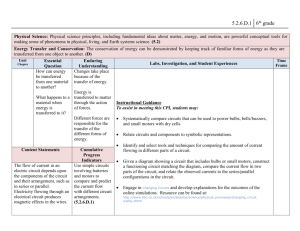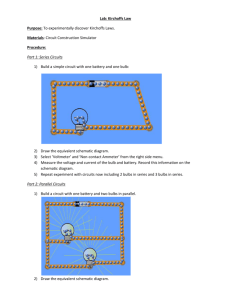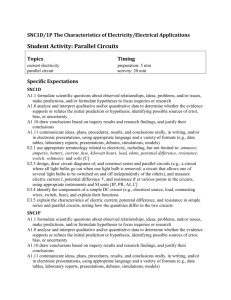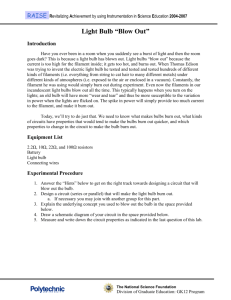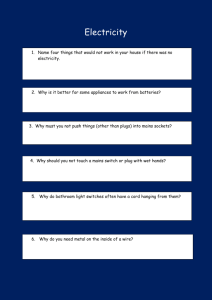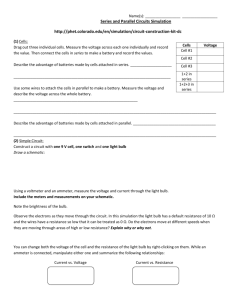1102 Lab 5 Circuits
advertisement
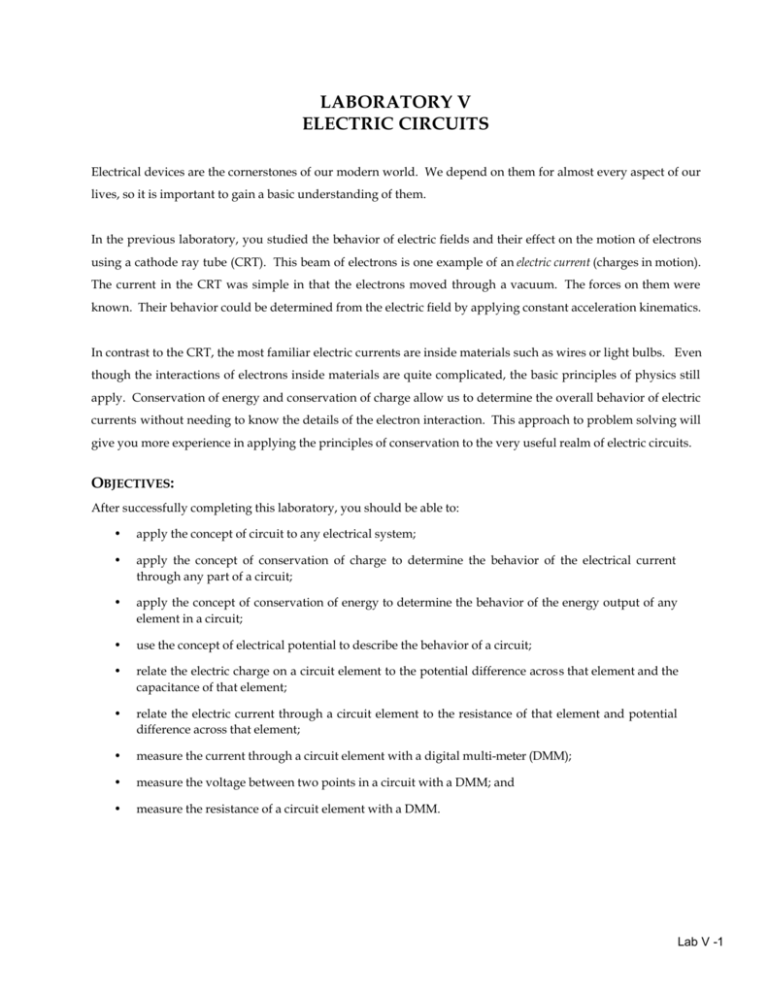
LABORATORY V ELECTRIC CIRCUITS Electrical devices are the cornerstones of our modern world. We depend on them for almost every aspect of our lives, so it is important to gain a basic understanding of them. In the previous laboratory, you studied the behavior of electric fields and their effect on the motion of electrons using a cathode ray tube (CRT). This beam of electrons is one example of an electric current (charges in motion). The current in the CRT was simple in that the electrons moved through a vacuum. The forces on them were known. Their behavior could be determined from the electric field by applying constant acceleration kinematics. In contrast to the CRT, the most familiar electric currents are inside materials such as wires or light bulbs. Even though the interactions of electrons inside materials are quite complicated, the basic principles of physics still apply. Conservation of energy and conservation of charge allow us to determine the overall behavior of electric currents without needing to know the details of the electron interaction. This approach to problem solving will give you more experience in applying the principles of conservation to the very useful realm of electric circuits. OBJECTIVES: After successfully completing this laboratory, you should be able to: • apply the concept of circuit to any electrical system; • apply the concept of conservation of charge to determine the behavior of the electrical current through any part of a circuit; • apply the concept of conservation of energy to determine the behavior of the energy output of any element in a circuit; • use the concept of electrical potential to describe the behavior of a circuit; • relate the electric charge on a circuit element to the potential difference across that element and the capacitance of that element; • relate the electric current through a circuit element to the resistance of that element and potential difference across that element; • measure the current through a circuit element with a digital multi-meter (DMM); • measure the voltage between two points in a circuit with a DMM; and • measure the resistance of a circuit element with a DMM. Lab V -1 LAB V: INTRODUCTION PREPARATION: • Describe the relationship between charge and current. • Describe the relationship between potential and potential energy. • Describe the essential difference between an insulator and a conductor. • Identify what is an electrical circuit and what is not. • Apply conservation of energy and conservation of charge to current flowing around a circuit. • Write down Ohm's law and know when to apply it. • Describe the difference between a capacitor, a resistor, and a battery. • Use a DMM to measure potential difference, current, and resistance. Lab V - 2 PROBLEM #1: BASIC CIRCUITS You need more light in your workroom, so you decide to add another light fixture to your track lighting. However, you are concerned that adding another light may dim the lights that already are in the track. When you proceed with the addition of another light, you notice that none of the lights are dimmer then before. You wonder what type of circuit your track lighting uses. So, you decide to build a model of circuits using two bulbs and compare the brightness of the bulbs in these circuits to a circuit with a single bulb. You know that the circuit where bulbs are as bright as your reference circuit is equivalent to the circuit that your track lighting uses. EQUIPMENT You will build the three simple circuits shown below out of wires, light bulbs, and batteries. Use the accompanying legend to help you build the circuits. Legend: light bulb battery wire Note: Some of the light bulbs in the lab may be of different kinds and have different resistances. To find identical light bulbs look for markings and check to see that the color of the plastic bead separating the filament wires is the same. PREDICTION Rank the order the brightness of bulbs A, B, C, D, and E from the brightest to the dimmest (use the symbol = for "same brightness as" and the symbol > for "brighter than"). Write down your reasoning. Are there any other two bulb circuits that are different then Circuit II or Circuit III? If yes, then draw them. If no, explain why. WARM-UP Read Serway & Vuille, Chapter 17, Section 17.4 and Chapter 18, Sections 18.2 and 18.3 (or Cutnell & Johnson 20.1, 20.2, 20.4, 20.6, and 20.7) Lab V - 3 PROBLEM #1: BASIC CIRCUITS 1. Consider Circuit I. Assume a constant value for the resistance of A. What is the voltage across A? What is the current through A? Which of these values will determine the brightness of A? 2. Consider Circuit II. Assume that light bulbs B and C have the same resistance as A (this is not entirely true, but it is an approximation that will lead you to the correct answer. Problem 4 will show you more about the resistance of a light bulb). How do resistors in series add up? Find the voltage and current for each bulb. How will the brightness of these bulbs compare with A? 3. Consider Circuit III. Assume that light bulbs D and E have the same resistance as A. How do resistors in parallel add up? Find the voltage and current for each bulb. How will the brightness of these bulbs compare with those in the previous two circuits? EXPLORATION Familiarize yourself with the equipment. If you have trouble setting up the drawn circuits, consult another group or your instructor. Test all of your batteries and bulbs. Light a single bulb with a single battery using the simplest possible circuit: one battery, one bulb (that is not in its socket), and one wire. How many different configurations can you find that light the bulb? If you find a configuration that works, would it still work if you reversed how the poles of the battery were connected? Try it. Look closely at the inside of a light bulb. Draw a picture of what you see. Also draw how you think the inside structure of the light bulb is connected to the outside. Write down your reasons. If the bulb does not light how can you tell what is wrong? Is the battery dead, the bulb burned out, or the circuit connected incorrectly? Reference Circuit: Connect Circuit I to use as a reference. Observe the brightness of bulb A. Replace the bulb with another one and again observe the brightness. Repeat until you have determined the brightness of all your bulbs when they are connected into the same circuit. If the bulbs are identical, they should have the same brightness. Circuit II: Connect Circuit II. Compare the brightness of bulbs B and C. What can you conclude from this observation about the amount of current through each bulb? Pay attention to large differences you may observe, rather than minor differences that may occur if two "identical" bulbs are not exactly identical. How can you test whether minor differences are due to manufacturing irregularities? Is more current going through the first bulb than going through the second, or is the current the same through both bulbs? Try switching bulbs B and C. Based on your observation, what can you infer about the current at points 1, 2, and 3? How is this related to conservation of charge? How does the brightness of bulb A (Circuit I) compare to the brightness of bulbs B and C (Circuit II)? What can you infer about the current at point 1 in the two circuits? How does the brightness of bulb A (Circuit I) compare to the brightness of bulbs B and C (Circuit II)? What can you infer about the current at point 1 of Circuit II compared to the current at point 1 of Circuit I? What do you think would happen to the brightness of the bulbs B and C if you added another bulb in the same row? Try it and find out. Can you explain your observations? Lab V - 4 PROBLEM #1: BASIC CIRCUITS Circuit III: Connect Circuit III. Compare the brightness of bulbs D and E. What can you conclude from this observation about the amount of current through each bulb? Describe the flow of current around the entire circuit. What do your observations suggest about the way the current through the battery divides and recombines at junctions where the circuit splits into two branches? How does the current at point 1 compare with the currents at points 2 and 3? How is this related to the conservation of charge? How does the brightness of bulb A (Circuit I) compare to the brightness of bulbs D and E (Circuit III)? What can you infer about the current at point 1 in Circuit III compared to the current at point 1 in Circuit I? Comparing the three circuits, does the amount of current at point 1 appear to depend on the number of bulbs in the circuit and how they are related? What do you think would happen to the brightness of bulbs D and E if you added another bulb in parallel to them? Try it. Can you explain your observations? CONCLUSION Rank order brightness of the bulbs. How did this compare to your prediction? What is the circuit that corresponds to your track lighting? Circuit II is called a "series circuit" and Circuit III is called a "parallel circuit". What does a battery do for a circuit? Does the battery supply a constant current to all circuits? Does the battery supply a constant energy to all circuits? Does the battery supply a constant potential difference to all circuits? Use your observations about bulb brightness to explain your answers. Check your conclusions about current by using a digital multi-meter (DMM) to directly measure the currents through parts of the circuits. Read Appendix A and become familiar with how to measure current with a digital multi-meter. Try measuring the current at point 1 in Circuit I. Did the bulb remain lit while you were measuring the current? Did the brightness of the bulb change when you began measuring the current. What happens if you choose a different scale on the DMM? (In other words, what happens if you turn the dial? Make sure you stay on the current measuring parts of the dial.) Measure the current through points 1, 2 and 3 in Circuit II. Do the same measurement for Circuit III. Do these measurements agree with your conclusions based on bulb brightness? Check your conclusions about potential difference by using a digital multi-meter (DMM) to directly measure the potential difference across parts of the circuits. Read Appendix A and become familiar with how to measure the potential difference across a circuit element using a DMM. Measure the potential difference across the two poles of the battery in Circuit I with the DMM. Did the bulb remain lit while you were measuring the current? Did the brightness of the bulb change when you began measuring the current? Try changing the scale of the DMM by turning the dial. Make sure you stay on the voltage measuring parts of the dial! What happens? Measure the potential difference across the poles of the battery when it is not connected to anything. How does that compare to circuit I? For Circuit I measure the potential difference across the battery and bulb A. What is the uncertainty in your measurement? In Circuit II and III measure the potential difference across the battery and across each bulb. Do these measurements agree with your conclusions based on bulb brightness? Lab V -5 PROBLEM #2: MORE COMPLEX CIRCUITS It is the holiday season once again and you decide to put up your decorations. You have three strings of decorative lights. To have enough lights in a row, you will need to connect two of your light strings together end to end. The other set of lights will be enough to light up your doorway. You know that you have a few different ways of connecting the light strings. However, you want to connect them so that they are as bright as possible. Before you begin the long process of decorating, you want to make sure that you are using the right set-up to get the brightest lights. So you build a reference circuit and a model of the two possible ways of hooking up the sets of lights in order to determine which gives the most light. In your model one light bulb represents a light string. EQUIPMENT You will build the three circuits shown below out of wires, light bulbs, and batteries. Use the accompanying legend to help you build the circuits. Legend: light bulb battery wire Note: Some of the light bulbs in the lab may be of different kinds and have different resistances. To find identical light bulbs look for markings and check to see that the color of the plastic bead separating the filament wires is the same. Lab V - 6 PROBLEM #2: MORE COMPLEX CIRCUITS PREDICTION Rank order the brightness of the bulbs A, B, C, D, E, F, G, H, J, and K from the brightest to the dimmest (use the symbol = for "same brightness as" and the symbol > for "brighter than"). Write down your reasoning. WARM-UP Read Serway & Vuille, Chapter 17, Section 17.4 and Chapter 18, Sections 18.2, 18.3 and 18.4 (or Cutnell & Johnson 20.1, 20.2, 20.4, 20.6, 20.7, and 20.10) 1. Consider Circuit I. Assume a constant value for the resistance of A. What is the voltage across A? What is the current through A? Which of these values will determine the brightness of A? 2. For the rest of the circuits, assume that the resistance of each bulb is the same as that of A (this is not entirely true, but it is an approximation that will lead you to the correct answer. Problem 4 will show you more about the resistance of a light bulb). In each circuit decide which bulbs are in parallel and which are in series. Using your knowledge of how resistors add up, find the total current flowing through the circuit. Then, using conservation of current and Ohm’s law, decide how much current is flowing through each bulb. Compare the current flowing through each bulb to that of A. How does this reflect the bulbs brightness in comparison to A? EXPLORATION Test your battery and all of your bulbs by using a single battery, a wire, and a bulb as you did in Problem #1. Reference Circuit: Connect Circuit I to use as a reference. Circuit IV: Connect Circuit IV. Compare the brightness of bulbs B and C. Compare the brightness of bulbs B and C to bulb D. What can you conclude from this observation about the amount of current through each bulb? Pay attention to large differences you may observe, rather than minor differences that may occur if two bulbs are not identical. How can you test whether minor differences are due to manufacturing irregularities or different currents through the bulbs? How does the brightness of bulbs B and C compare to the brightness of bulb A (Circuit I)? What can you infer about the current at point 2 in Circuit IV compared to the current at point 1 in Circuit I? How does the brightness of bulb D compare to the brightness of bulb A (Circuit I)? What can you infer about the current at point 3 in Circuit IV compared to the current at point 1 in Circuit I? Describe the flow of current around the entire circuit. What do your observations suggest about the way the current divides and recombines at junctions where the circuit splits into two branches? How does the current at point 1 compare with the currents at points 2 and 3? Lab V -7 PROBLEM #2: MORE COMPLEX CIRCUITS Circuit V: Connect Circuit V. Compare the brightness of bulbs F and G. Compare the brightness of bulbs F and G to bulb E. What can you conclude from this observation about the amount of current through each bulb? How does the brightness of bulb E compare to the brightness of bulb A (Circuit I)? What can you infer about the current at point 1 in Circuit V compared to the current at point 1 in Circuit I? How does the brightness of bulb E compare to the brightness of bulb B (Circuit IV)? If you do not have enough equipment, you may need to team up with another group so that you can build both for comparison. Or, you can switch between Circuit IV and Circuit V quickly by switching the wire connected to the top of bulb G to the top terminal of bulb E. Watch the brightness of bulb E while you do this. What can you infer about the comparison of the current at point 2 in both circuits? Describe the flow of current around the entire circuit. What do your observations suggest about the way the current divides and recombines at junctions where the circuit splits into two branches? How is this related to the conservation of charge? How does the current through point 2 compare with the currents through points 1, 3 and 4? Circuit VI: Connect Circuit VI. Compare the brightness of the bulbs. What can you conclude from this observation about the amount of current through each bulb? How does the brightness of bulb H compare to the brightness of bulb A (Circuit I)? What can you infer about the current at point 1 in Circuit VI and the current at point 1 in Circuit I? CONCLUSION Rank the order the actual brightness of the bulbs A, B, C, D, E, F, G, H, J, and K. How did your prediction compare to your results? Can you use the conservation of energy and the conservation of current to explain your results? How will you connect your three strings of lights? Check your conclusions about current by using a digital Multimeter (DMM) to directly measure the currents through parts of the circuits. Read Appendix A if you are not familiar with how to measure current with a digital Multimeter. Review your notes from Problem 1. Measure the current through the numbered points in all the Circuits and compare them. Do these measurements agree with your conclusions based on bulb brightness? Check your conclusions about potential difference by using a digital Multimeter (DMM) to directly measure the potential difference across parts of the circuits. Read Appendix A if you are not familiar with how to measure the potential difference across a circuit element using a DMM. Review your notes from Problem 1. Measure the potential difference across the battery and across each bulb in all the circuits and compare them. Do these measurements agree with your conclusions based on bulb brightness? Lab V - 8 PROBLEM #3: SHORT CIRCUITS While decorating for the next holiday, you notice that a few of the bulbs on a string of lights do not light up when you turned them on. You take the bulbs out and check them in a different string of lights and observe that the bulbs still work. You wonder why they don't work in the first set of lights. A friend tells you that you must have a short circuit. Your friend explains that you have a short circuit when a wire makes an alternate path for the current to bypass a circuit element. To help understand this idea, you build a few simple circuits to show you the results of a short circuit. EQUIPMENT You will build the three simple circuits shown below out of wires light bulbs, and batteries. Use the accompanying legend to help you build the circuits. Legend: light bulb battery wire Note: Some of the light bulbs in the lab may be of different kinds and have different resistances. To find identical light bulbs look for markings and check to see that the color of the plastic bead separating the filament wires is the same. PREDICTIONS Circuit I: What happens to the brightness of the bulb A when a wire is attached across the bulb? Circuit II: What happens to the brightness of bulbs B and C when a wire is attached across bulb B (from point 1 to point 2)? Circuit III: What happens to the brightness of bulbs D and E when a wire is attached across bulb E? Read Serway & Vuille, Chapter 17, Section 17.4 and Chapter 18, Sections 18.2 and 18.3 (or Cutnell & Johnson 20.2, 20.4, 20.6, and 20.7) Lab V - 9 PROBLEM #3: SHORT CIRCUITS EXPLORATION WARNING: A short circuit is what happens any time a very low-resistance path (like a wire, or other piece of metal) is provided between points in a circuit that are at voltages, like the terminals of a battery or power supply. Short circuits can destroy equipment and injure people! Always avoid short circuits in other circuits! Short circuits damage equipment by creating large currents in a circuit that is not designed for large currents. These currents can cause great heat and cause damage to nearby circuit elements or measuring devices. Any short circuits suggested in this manual have been tested, and determined not to significantly damage the equipment. Build Circuit I. Place a wire across the bulb. What happens to the brightness of the bulb? Hold on to the wire that is across the bulb. Is it getting warmer? How did the current through the bulb change? The current coming out of the battery? Disconnect the battery. Placing the wire across the bulb causes a short circuit and it is called "shorting out" the bulb. Build Circuit II. What happens to the brightness of bulbs B and C when you place a wire across bulb B? How did the current through C change? The current through B? Did the current through point 1 change? In what way? Is the wire across bulb B getting warm? Explain your answers. Build Circuit III. What happens to the brightness of bulbs D and E when you place a wire across bulb E? Did the current through D change? The current through E? Is the wire across bulb E getting warm? What would be the brightness of a bulb inserted in the circuit at point 1? Explain your answers. CONCLUSION Did your predictions match your observed results? Explain your answers. Lab V - 10 PROBLEM # 4: RESISTORS AND LIGHT BULBS Your research team has built a device for monitoring the ozone content in the atmosphere to determine the extent of the ozone holes over the poles. You have been assigned the job of keeping the equipment at the South Pole running during the winter months when no supplies can get in. When a piece of equipment fails, you need to replace two resistors. Unfortunately you have only one. You do have a light bulb but you are not sure if the bulb acts enough like a resistor to make the circuit work. You decide to make a direct comparison. EQUIPMENT You will have wires, a power supply (18V5A), a Digital Multimeter (DMM), a light bulb, and a resistor. PREDICTIONS Draw a sketch of what you expect a graph of voltage versus current to look like for (a) the standard resistor, and (b) the light bulb. Explain your reasoning. WARM-UP Read Serway & Vuille, Chapter 17, Section 17.4 and 17.6 (or Cutnell & Johnson 20.2 and 20.3) 1. What is the relationship between the current through a resistor and the potential difference (voltage) across the resistor if the resistor is made of ohmic material? Draw a graph of current versus voltage for this resistor. How is the slope of the graph related to its resistance? 2. As more current goes through a light bulb, it gets brighter which means it gets hotter. Do you expect the increasing temperature to affect the resistance of the bulb? If so, how? Sketch a graph of voltage versus current for the light bulb. EXPLORATION WARNING: You will be working with a power supply that can generate large electric voltages. Improper use can cause painful burns. To avoid danger, the power should be turned OFF and you should WAIT at least one minute before any wires are disconnected from or connected to the power supply. Never grasp a wire by its metal end. Lab V - 11 PROBLEM #4: RESISTORS AND LIGHT BULBS Sketch the circuit you will build to check your prediction. Can you test both the light bulb and the resistor at the same time? Is this a good idea? Read Appendix A and get familiar with the different operations of the Digital Multimeter (DMM). MEASUREMENT There are three methods for determining the electrical resistance of a resistor: 1. Use the chart provided in Appendix A to determine the resistance of your resistor based on its color code. What is the uncertainty in this value? 2. Use the DMM set to ohms to measure the resistance of the resistor. What is the uncertainty in this value? Why is this procedure not helpful with a light bulb? 3. Use your power supply, DMM, and resistor to determine the voltage across the resistor and measure the current through the resistor for several different voltages. What is the uncertainty in the value of the resistance obtained by this method? ANALYSIS Make a graph of voltage versus current for your resistor and light bulb. How do the values of the resistance compare for the different methods used? CONCLUSION Are the color-coded resistor and light bulb both ohmic resistors? If so, what are their resistances? Did your prediction match your results? If not, can you use the bulb over some limited range of current? What range? Explain your reasoning. Lab V - 12 PROBLEM #5: CIRCUIT ANALYSIS You have a summer job in an electronics company that requires you to make quick judgments about the relative amounts of current through different resistance in complex circuits. You have been calculating the current through each resistor but it takes time. A fellow worker suggests that using a qualitative analysis you can get the same results much faster. You decide to try this technique on several circuits using identical light bulbs so that the brightness of the bulb indicates the relative current through it. You will compare your qualitative results to those you get from a calculation. EQUIPMENT You will have batteries, wires, and five identical light bulbs that you can connect to make the three circuits shown below. Note: Some of the light bulbs in the lab may be of different kinds and have different resistances. To find identical light bulbs look for markings and check to see that the color of the plastic bead separating the filament wires is the same. PREDICTIONS 1. Use the qualitative intuition you have developed in the previous problems to complete the following predictions. For each prediction, state which rule(s) you used. Circuit IX: How will the brightness of bulb A compare with the brightness of bulb B? How will the brightness of bulb B compare with the brightness of bulb D? How will the brightness of bulb C compare with the brightness of bulb D? Circuit X: How will the brightness of bulb A compare with the brightness of bulb B? How will the brightness of bulb B compare with the brightness of bulb C? How will the brightness of bulb B compare with the brightness of bulb D? Lab V - 13 PROBLEM #5: CIRCUIT ANALYSIS Circuit XI: How will the brightness of bulb A compare with the brightness of bulb B? How will the brightness of bulb B compare with the brightness of bulb C? How will the brightness of bulb B compare with the brightness of bulb D? 2. Check your qualitative predictions by calculating the current through each bulb to predict the relative bulb brightness in the three circuits. WARM-UP Read Serway & Vuille, Chapter 17, Section 17.4 and Chapter 18, Sections 18.2, 18.3 and 18.4 (or Cutnell & Johnson 20.2, 20.6, 20.7, and 20.10) 1. If resistors are connected in series how does the current through them compare? Resistors in series add. Does the current through a path across a fixed potential difference increase, decrease, or stay the same if the total resistance of the path increases? 2. What happens to currents at a junction? In a parallel circuit, is the potential difference across each path the same or does it depend on the resistance of that path? In a parallel circuit, is the current in each path, always the same, larger if the resistance is larger or smaller if the resistance is larger? 3. If resistors are connected in parallel, is the total current through all the branches more, less, or the same as the current through the branch with the smallest resistance? From that answer, is the total resistance of the entire parallel part of the circuit more, less, or the same as the smallest resistance in the one branch? 4. If parallel branches of a circuit exist, does changing the resistance in one branch change the current in the other branches? Does it change the potential difference across the other branches? Since the brightness of a bulb depends on the current through it, you can now use these answers to make the qualitative predictions. The following questions will help you calculate the currents in the circuits that are consequences of conservation of charge, conservation of energy, and Ohm's law in electric circuits. 5. Draw and label a circuit diagram showing all voltages, and resistance. Sometimes you may need to redraw the given circuit to help yourself see which resistors are in series and which are in parallel (not necessary in this case). For this problem, the voltages and the resistors (the resistors are all equal) are the known quantities and the current in each resistor is the unknown. 6. Assign a separate current for each leg of the circuit. Indicate your guess for the direction of that current by an arrow on the diagram. If your guess about the current direction is wrong, you will get a minus sign for its value. 7. Apply the conservation of current at each point in the circuit at which wires come together (a junction) to get an equation that relates the currents. Be careful, not all of these equations are independent. You can only use the ones that are. Lab V - 14 PROBLEM #5: CIRCUIT ANALYSIS 8. Identify the number of circuit paths (loops) and label them on the diagram. Use conservation of energy to get the sum of the potential differences across all of the elements in each loop. Make sure your signs are correct. Does the potential difference increase or decrease across each circuit element in the direction you have chosen to follow the current? Use Ohm's law to get the potential difference across each resistor. Again be careful, not all of the loop equations are independent. You can only use the ones that are. 9. Check that the number of equations from Warm-Ups 7 and 8 matches the number of unknowns. It is easy to write down more but they add no useful information. If you choose equations that are not independent, your algebra will not result in a solution. 10. Solve your equations for one of the unknown currents and express the other currents in terms of the first current. Simplify your equations as much as possible. EXPLORATION AND MEASUREMENT Set up each circuit and observe the brightness of the bulbs. How can you test whether minor differences you observe are due to manufacturing irregularities in the "identical" bulbs? How can you test whether minor differences you observe are due to manufacturing irregularities in the "identical" bulbs? As a check, use a DMM to measure the current through the bulbs (see Appendix A). This is also useful in case you need to check whether a light bulb is unlit or just very dim. ANALYSIS AND CONCLUSION Explain any differences between your qualitative predictions, your calculated predictions, and your observations. Qualitative circuit analysis is very useful for quickly checking the results of the algebra that come from quantitative circuit analysis. It is a great way to catch mistakes before you fry expensive circuits. Lab V -15 PROBLEM #6: SIMPLE CIRCUITS WITH CAPACITORS You and your friend are trying to determine if you can use a capacitor to limit the current from a battery in the case of short circuits. You suggest that you try a simple circuit with a capacitor, originally uncharged, connected to a battery through a switch. To monitor the current, you also put a bulb in series with the capacitor. Your friend believes that when the switch is closed the capacitor charges up and the bulb gets brighter and brighter until the brightness levels off. The bulb then stays on until the switch is opened. Do you agree? EQUIPMENT You can build the simple circuit shown below out of wires, light bulbs, capacitors and batteries. Use the accompanying legend to help you build the circuits. You will also have a stopwatch and a Digital Multimeter (DMM). Legend: light bulb battery capacitor switch wire PREDICTION How do you think the brightness of the light bulb changes over time? Explain. Sketch a graph of brightness versus time assuming the capacitor is initially uncharged. Read Serway & Vuille, Chapter 18, Section 18.5 (or Cutnell & Johnson 20.13) EXPLORATION WARNING: A charged capacitor can discharge quickly producing a painful spark. Do not handle the capacitors by their electrical terminals or connected wires by their metal ends. Always discharge a capacitor with a wire when you are finished using it. To discharge a capacitor, use an insulated wire to briefly connect one of the terminals to the other. Lab V - 16 PROBLEM #6: SIMPLE CIRCUITS WITH CAPACITORS Examine each element of the circuit before you build it. How do you know if the battery is "good?" Is the capacitor charged? Carefully connect the two terminals of the capacitor to ensure it is uncharged. How can you build a “switch” from the materials given? NOTE: Be sure that the polarity of the capacitor’s connection is correct -- that the part of the circuit connected to the battery’s “+” terminal is connected to the capacitor’s “+” terminal, and the part of the circuit connected to the battery’s “-“ terminal is connected to the capacitor’s “-“ terminal. Reversing the polarity would irreversibly change the capacitor’s capacitance. After you are convinced that all of the circuit elements are working and that the capacitor is uncharged, connect Circuit XII with the switch in the off (open) position. Complete the circuit and observe how the brightness of the bulb changes over time. At the instant the circuit is completely connected, how does the brightness of the bulb compare to the brightness of the bulb from Circuit I (Problem #1)? You may need to build circuit I to compare. From your observation of the bulb's brightness, how does the current through the bulb change over time? You can check this using the DMM set for current (Amps). See Appendix A for the use of the DMM. Using the picture of the capacitor as two parallel plates that do not touch, how does the current through the capacitor change over the same time? Can you measure this with the DMM? Use the conservation of charge to explain what you observe. What can you infer about the change of the charge in the capacitor? From what you know about a battery, how does the potential difference (voltage) across the battery change over time? Check this using the DMM set for potential difference (Volts). From your observations of the brightness of the bulb, how does the potential difference across the bulb change over time? Check this using the DMM. What can you infer about the change of voltage across the capacitor over time? Can you check with a DMM? Use the concept of potential difference to explain what you observe. After a few moments, disconnect a wire from the circuit. Is the capacitor charged or uncharged? To determine if the capacitor is charged, carefully (and safely) remove the battery from Circuit XII and reconnect the circuit without the battery. With only the capacitor, switch, and bulb (no battery) in the circuit, will the bulb light if you close the switch and the capacitor is charged? Uncharged? Try it. Was the capacitor charged before you closed the switch? Was the capacitor still charged a long time after the switch was closed? Use the conservation of charge and the concept of potential difference to explain your results. CONCLUSION Was your friend right about how the brightness of the bulb changed over time? Sketch a qualitative graph of the brightness of the bulb as a function of time after you close the switch on Circuit XII. How does this compare to your prediction? Lab V -17 PROBLEM #7: CAPACITANCE As part of theatrical production, the director of the play wants a light bulb to dim very slowly to heighten the dramatic effect. You have been asked to demonstrate different rates of dimming for the light bulb so the director can select the one necessary for the performance. You decide to design a simple, inexpensive circuit to automatically accomplish this task. You test your design by connecting a battery, a switch, a light bulb, and a capacitor in series. You need to determine how to adjust the rate of dimming of the light bulb by changing capacitors. EQUIPMENT You can build the simple circuit shown below out of wires, light bulbs, capacitors and batteries. Use the accompanying legend to help you build the circuits. You will also have a stopwatch to measure time intervals. Legend: light bulb battery capacitor switch wire PREDICTION From your experience, make an educated guess about how the time that the light bulb is lit depends on the capacitance of the capacitor. Sketch a graph of the time it takes for the light bulb to turn completely off as a function of the capacitor’s capacitance. Assume the capacitor is initially uncharged. Write down what you mean when you say the light bulb is completely off. Read Serway & Vuille, Chapter 18, Section 18.5 (or Cutnell & Johnson 20.13) Lab V - 18 PROBLEM #7: CAPACITANCE EXPLORATION WARNING: A charged capacitor can discharge quickly producing a painful spark. Do not handle the capacitors by their electrical terminals or connected wires by their metal ends. Always discharge a capacitor before you use it and after you are finished using it. To discharge a capacitor, use an insulated wire to briefly connect one of the terminals to the other. Examine each element of the circuit before you build it. How do you know if the battery is "good"? Be sure the capacitors are uncharged. NOTE: Be sure that the polarity of the capacitor’s connection is correct -- that the part of the circuit connected to the battery’s “+” terminal is connected to the capacitor’s “+” terminal, and the part of the circuit connected to the battery’s “-“ terminal is connected to the capacitor’s “-“ terminal. Reversing the polarity would irreversibly change the capacitor’s capacitance. After you are convinced that all of the circuit elements are working and that the capacitor is uncharged, connect Circuit IX with the switch in the off (open) position. Close the switch and observe how the brightness of the bulb changes over time. How long does it take for the bulb to turn off? Develop a measurement plan that will allow you to determine the time it takes a bulb to turn off as a function of capacitance. You will want to decide how many different capacitors you need to use, how many time measurements to take for each capacitor, and what do you mean by the light bulb being off. MEASUREMENT Use your measurement plan to record how long it takes for the light bulb to turn off for each capacitor in Circuit XII. ANALYSIS Graph the time it takes for the light bulb to turn off versus capacitance, assuming the capacitor is initially uncharged. CONCLUSION How did your measurement compare your prediction? Using the conservation of charge and the concept of potential difference, explain how the capacitance affects the time it takes for the bulb to turn off. Lab V -19 PROBLEM #8: CIRCUITS WITH TWO CAPACITORS You have been asked to evaluate two circuits that could be used to automatically dim the lights for your theatrical production in a time shorter than a battery, a capacitor, and a bulb. Each circuit uses two capacitors, one battery and one bulb. All of the batteries, capacitors, and bulbs that you have are identical. In one circuit they are connected with a light bulb in series and in the other in parallel. Which one, if either, would you choose? EQUIPMENT Build the circuits shown below out of wires, bulbs, 2 equal capacitors, and batteries. accompanying legend to help you build the circuit. You will also have a stopwatch. Use the Legend: light bulb A + - + - B battery capacitor switch Circuit XII wire Circuit XIII + C Circuit XIV PREDICTION Rank order the total time it takes for each of the bulbs A, B, and C to turn off (use the symbol = for "same time as," the symbol > for "more time than," and the symbol Ø if the bulb never lights). Explain your reasoning. WARM-UP Read Serway & Vuille, Chapter 18, Section 18.5 and Chapter 17, Sections 16.7 and 16.8 (or Cutnell & Johnson 20.12 and 20.13) Lab V - 20 PROBLEM #8: CIRCUITS WITH TWO CAPACITORS 1. 2. 3. Draw the three circuits. Decide which circuit has the capacitors in series and which has the capacitors in parallel. Write down how capacitance combines for both series and parallel circuits. Assuming all the individual capacitors have the same capacitance, rank the three circuits in order of effective capacitance. How does capacitance affect the amount of time a bulb stays lit? Rank the circuits in order of how long the bulb will stay lit. Is there a circuit that will not go out when connected? If so, how long will the bulb stay lit after the battery is disconnected? Relate this length of time to the times that the other circuits stay lit. EXPLORATION WARNING: A charged capacitor can discharge quickly producing a painful spark. Do not handle the capacitors by their electrical terminals or connected wires by their metal ends. Always discharge a capacitor before you use it and when you are finished using it. To discharge a capacitor, use an insulated wire to briefly connect one of the terminals to the other. Make sure all of your capacitors are uncharged before starting the exploration and that they have the same capacitance. Review your exploration and measurement plan from Problem #7. Connect Circuit XII to use as a reference. NOTE: Be sure that the polarity of the capacitor’s connection is correct -- that the part of the circuit connected to the battery’s “+” terminal is connected to the capacitor’s “+” terminal, and the part of the circuit connected to the battery’s “-“ terminal is connected to the capacitor’s “-“ terminal. Reversing the polarity would irreversibly change the capacitor’s capacitance. Connect Circuit XIII, but do not hook up the battery yet. Do you think bulb B will light when the battery is hooked up? Record your reasoning in your journal. Complete the circuit by hooking up the battery. Record your observations and explain what you saw using the conservation of charge and the concept of potential difference. Does the order that you connect the two capacitors and the bulb in the circuit matter? Try following one capacitor with the other capacitor and then the bulb. Connect Circuit XIV, but do not hook up the battery yet. Do you think bulb C will light when the battery is hooked up? Record your reasoning in your journal. Complete the circuit by hooking up the battery. Record your observations and explain what you saw using the conservation of charge and the concept of potential difference. Develop a plan for measuring the time it takes for bulbs A, B and C to turn off, if they light at all. Lab V -21 PROBLEM #8: CIRCUITS WITH TWO CAPACITORS MEASUREMENT Use your measurement plan to record how long it takes for the light bulb to go off for each circuit. Use 0 seconds for bulbs that did not light. What are the uncertainties in these measurements? ANALYSIS Rank order the actual time it took each bulb to turn off. Do any of the bulbs initially light? Do all the bulbs go off? CONCLUSION How did your initial ranking of the time it would take for the bulbs to go out compare with what actually occurred? Use the conservation of charge to explain your results and the concept of potential difference to explain your results. Lab V - 22 þCHECK YOUR UNDERSTANDING 1. What would happen to the brightness of bulb A in the circuit below if more bulbs were added parallel to bulbs B and C? In household circuits, bulb A is in the same position as a fuse or circuit breaker. Why? 2. Rank order Circuits I through IV from the largest current at point 1 to the smallest current at point 1. Explain your reasoning. 3. Predict what will happen to the brightness of bulbs A, B, C and D if bulb E were removed from its socket. Explain your reasoning. Lab V - 23 CHECK YOUR UNDERSTANDING 4. For the circuit below, determine the current in each resistor. 8Ω 12 Ω + - 24 V 6Ω 24 Ω 5. 36 Ω For the circuit below, determine the value for R such that the current I3 is 0.1A with the indicated direction. 5Ω + - 20 Ω R 3V + 6V I3 What is the value for R that will give a current I3 = 0.1 A, but in the opposite direction as what is shown? Lab V - 24 TA Name: PHYSICS 1102 LABORATORY REPORT Laboratory V Name and ID#: Date performed: Day/Time section meets: Lab Partners' Names: Problem # and Title: Lab Instructor's Initials: Grading Checklist Points LABORATORY JOURNAL: PREDICTIONS (individual predictions and warm-up completed in journal before each lab session) LAB PROCEDURE (measurement plan recorded in journal, tables and graphs made in journal as data is collected, observations written in journal) PROBLEM REPORT:* ORGANIZATION (clear and readable; logical progression from problem statement through conclusions; pictures provided where necessary; correct grammar and spelling; section headings provided; physics stated correctly) DATA AND DATA TABLES (clear and readable; units and assigned uncertainties clearly stated) RESULTS (results clearly indicated; correct, logical, and well-organized calculations with uncertainties indicated; scales, labels and uncertainties on graphs; physics stated correctly) CONCLUSIONS (comparison to prediction & theory discussed with physics stated correctly ; possible sources of uncertainties identified; attention called to experimental problems) TOTAL(incorrect or missing statement of physics will result in a maximum of 60% of the total points achieved; incorrect grammar or spelling will result in a maximum of 70% of the total points achieved) BONUS POINTS FOR TEAMWORK (as specified by course policy) * An "R" in the points column means to rewrite that section only and return it to your lab instructor within two days of the return of the report to you. Lab V- 25 Lab V - 26

